Laptop Mag Verdict
Asus’ Zenfone 10 is the last bastion of hope for small flagship phone fans and it carries that banner proudly, delivering performance, battery life, and a primary camera that belies its diminutive size.
Pros
- +
Bright, vivid up to 144Hz display
- +
Solid primary, selfie cameras
- +
Nearly 13 hours of battery life
- +
Unique, pocketable design
- +
Powerful Snapdragon 8 Gen 2 chip
Cons
- -
Disappointing ultra-wide and no telephoto
- -
Software support falls short
Why you can trust Laptop Mag
The Asus Zenfone 10 is here to show Apple everything it did wrong with the iPhone mini (RIP), and while I know that phone had its fans, the simple truth is that it came up short in several regards compared to real flagship phones — most notably battery life.
Despite its small stature, the Zenfone 10 will outlast the majority of its flagship rivals with nearly 13 hours of battery life in its default settings. You might be thinking, “What kind of middling CPU did they drop in there to putter along for that many hours?” The Zenfone 10 might slap you for that question if it weren’t so polite, but it features the current pinnacle of Android performance: the Qualcomm Snapdragon 8 Gen 2. It doesn’t stop there, the pint-size wunderkind also packs up to 16GB of RAM if you want to leave all of your apps running just because you can.
So what is the trade-off for the diminutive dynamo? The camera experience is where things fail to reach the best of the best like Google’s Pixel phones or the iPhone 14 Pro models. It’s not bad, just a mixed bag rather than the unquestionable success of the rest of the package.
It’s not perfect, but the Asus Zenfone 10 is one of the best phones of the year and far and away the best small flagship phone I’ve ever reviewed, but read on to see if that makes it the right choice for you.
Asus Zenfone 10 pricing and configurations
Unfortunately the price of the Zenfone 10 remains a mystery at the moment. Asus will launch the phone toward the end of Q3 (most likely September), so we’re expecting an answer to this all-important question as we get closer to the official launch.
However, if we go off its predecessors we can assume it will start at around $699 for the base model with 8GB of RAM and 128GB of storage. You’ll be able to pay slightly more to double that storage, or spring for the top-end model that we reviewed which features 16GB of RAM and 512GB of storage. Last year there was only a $100 difference between the base and the maxed-out model.
You can select from a quintet of colors: Midnight Black, Starry Blue, Aurora Green, Eclipse Red, or Comet White.
Sign up to receive The Snapshot, a free special dispatch from Laptop Mag, in your inbox.
With the OnePlus 11 starting at $699 and the Google Pixel 7a at $499, there’s stronger competition than ever before in this $500-$700 range, so hopefully Asus can keep the price in that range.
Asus Zenfone 10 design
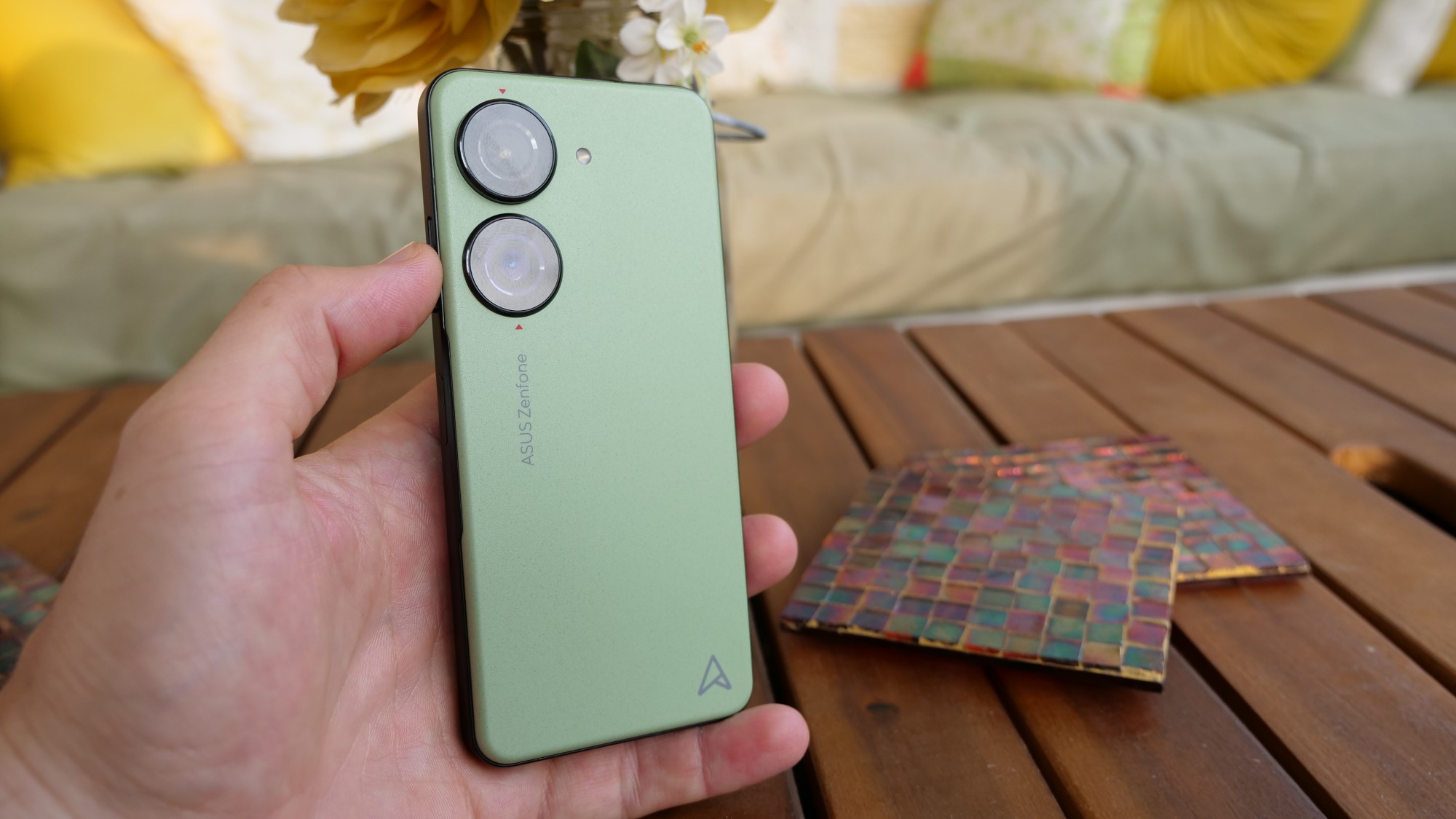
With its tiny frame and absolutely massive camera lenses on the back the Asus Zenfone 10 could be the star of a WALL-E spin-off. It feels like it is staring up at me with big puppy dog eyes when I leave it laying down horizontally on my desk, and I’m only too happy to pick it up and start playing with it again.
What’s more those giant cameras are actually surrounded by a colorful rear shell — Aurora Green on my review unit — and instead of a cold and slippery glass back, it features a grippy textured plastic that makes an inexplicably satisfying sound. I’m reasonably sure you could launch a successful ASMR YouTube channel just using the sound from the back of the Zenfone 10. The back also features a flash to the right of the upper camera, the text “ASUS Zenfone” below the cameras, and in the bottom right corner is a minimal Asus logo in light grey.
Touring around the rest of the Zenfone 10; on the bottom, you have the USB-Type C port and SIM slot, on the right side you have the “Smart key” (a multi-function button) and volume rocker, and finally on top, you have a 3.5mm headphone jack. No, I’m not hallucinating, this puny phone managed to fit in that audio port that Apple, Samsung, Google, and well basically everyone tells you they don’t have space for anymore.
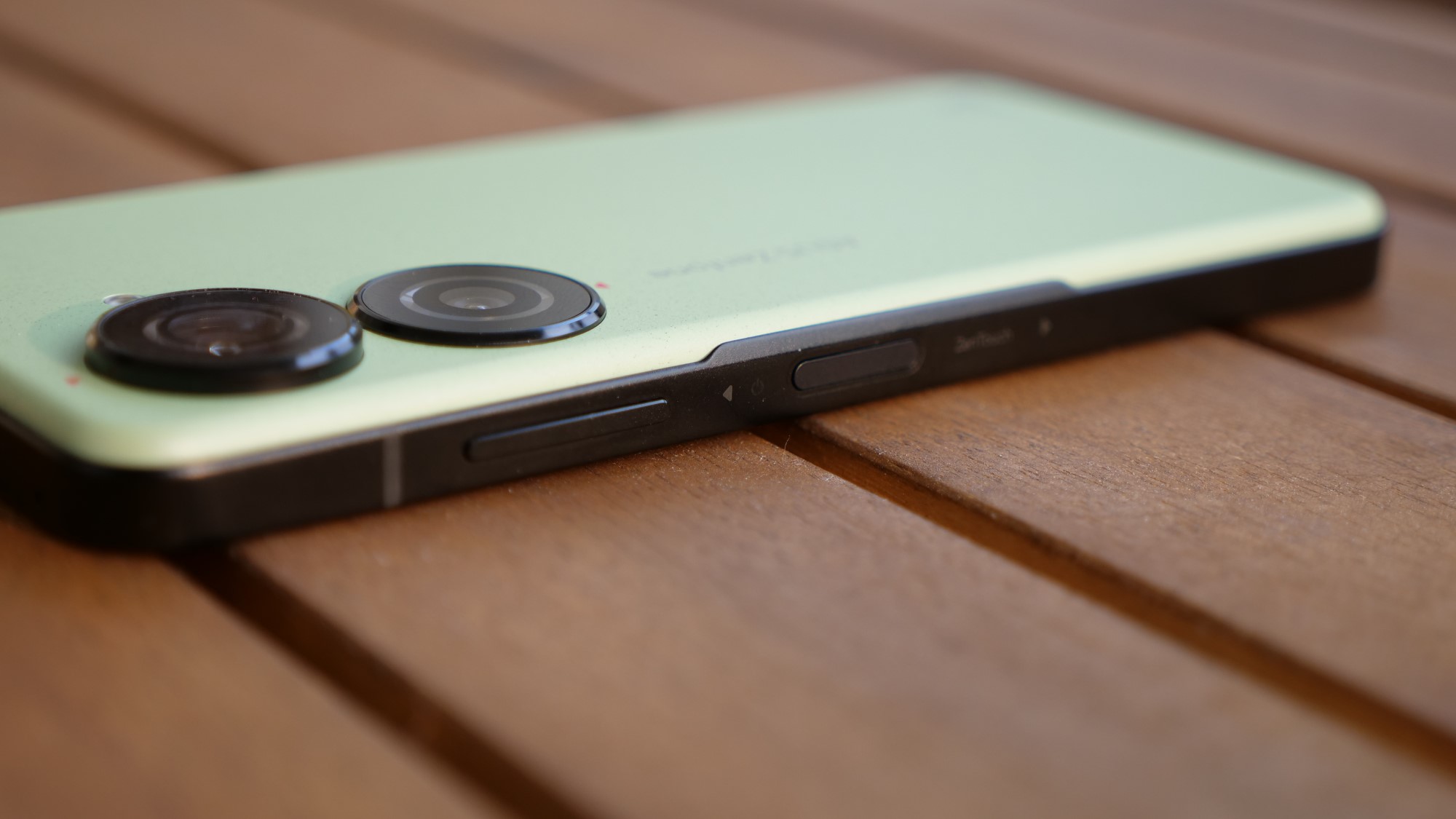
That plastic back only extends about 1mm off the back of the phone, the rest is a glossy black (or silver if you pick Comet White), which makes for a nice contrast. Flipping the phone over to the front you have a flat display with minimal bezels and a small hole-punch front-facing camera somewhat surprisingly located in the upper-left corner of the display.
So it’s got a “little” 5.9-inch display, but is it actually a small phone? Yes, at 5.8 x 2.7 x 0.37 inches and just 6.1 ounces, this is the most pocketable phone you will find that doesn’t fold. The Google Pixel 7a with its 6.1-inch display seemed small when I reviewed it, but at 6.1 x 2.9 x 0.34 inches and 7 ounces, it is considerably larger than the Zenfone. Needless to say the OnePlus 11 with its 6.7-inch display looks like a cruiser-class starship compared to these two, coming in at 6.4 x 2.9 x 0.33 inches and 7.2 ounces.
I love basically every design choice that Asus made with the Zenfone 10. Not only is it small in a world of lumbering giant phones, but it also has a unique look and texture that is unlike any other phone that I’ve reviewed in the past year.
Asus Zenfone 10 display

If you thought that Asus would cheap out on the small display, you were wrong, this display is so packed with features it could be a neutron star (they are very dense). The 5.9-inch AMOLED panel features an FHD+ (2400 x 1800) resolution and up to a 144Hz refresh rate. It will only summon the Speed Force and hit 144Hz in supported games though, typically it tops out at 120Hz.
I returned to my typical HDR-infused comfort watch of Our Planet II, although things were a little tense with an arctic fox battling some disgruntled geese. With the obvious caveat that it’s not the broad canvas of a larger display, the image on the Zenfone 10 is crisp and bright with the bright white feathers and fur flying and settling into the tufts of green brush as the geese attempted to defend their nests from the scraggly interloper. A shot of the nefarious little fox stealing one of the eggs was the perfect encapsulation of what this display has to offer with vibrant greens, oranges, and yellows dotting the landscape around the brown nest lined with the white goose down. A flash of the fox’s orange eyes as it picks up the egg and scampers off seals the deal.

The Asus Zenfone 10 shined in our lab testing as well, delivering scores to rival Samsung, not something I ever find myself saying. It reproduced 105.4% of the DCI-P3 color gamut on its default “Splendid Optimal” display setting and 124.2% in its Splendid Natural setting. Beyond my appreciation for the random insertion of splendid into the names, it was enough for an easy victory over the That was enough for a victory over the Pixel 7a (92% (Adaptive), 79.1% (Natural)) and the OnePlus 11 (83% (Natural), 121.3% (Vivid)).
The Delta-E color accuracy test results (lower is better) for the Zenfone 10, was the lone disappointment. At 0.35 in Optimal and 0.39 in Natural, it is behind the OnePlus 11 (0.24 (Natural), 0.31 (Vivid) and absolutely obliterated by the Pixel 7a (0.06 (Adaptive), 0.05 (Natural)).
Brightness on the Zenfone 10 topped out at 772 nits on its SDR setting. This was well beyond the OnePlus 11’s 470 nits, but not enough to overshadow the Pixel 7a at 1,024 nits.
Now assuming we’re right about the pricing and this comes in at or below $700, the display is one of the most impressive tricks Asus has pulled, you will love watching content on this phone.
| Display benchmark | Asus Zenfone 10 | OnePlus 11 | Google Pixel 7a |
|---|---|---|---|
| Brightness | 772 nits | 470 nits | 1,024 nits |
| DCI-P3 color gamut | 105.4%/124.2% (Optimal/Natural) | 83%/121.3% (Natural/Vivid) | 79.1%/92% (Natural/Adaptive) |
| Delta-E color accuracy | 0.35/0.39 Optimal/Natural) | 0.24/0.31 (Natural/Vivid) | 0.05/0.06 (Natural/Adaptive) |
Asus Zenfone 10 audio

If the inclusion of a 3.5mm headphone jack in the year 2023 didn’t convince you that Asus cared about the audio experience on the Zenfone 10, then the rest of the specs should do the trick. If you aren’t opting to plug in the phone offers a pair of stereo speakers and support for spatial sound thanks to Dirac Virtuo and hi-res lossless audio courtesy of Qualcomm aptX Lossless.
I listened to “Sunflower” by Post Malone because my son has had it on repeat again after seeing Spider-Man: Across the Spider-Verse. It remains an infectious tune and the relaxed beat and auto-tune heavy lyrics sound as good as ever on the Zenfone 10 speakers with plenty of volume to fill my 18 x 12 listening space without distortion.
If you are an audio enthusiast then you need to activate the AudioWizard in Quick Settings which gives you access to different scenario effects: Dynamic, Music, Cinema, or Gaming. You can also tinker with treble, bass, and 10 equalizer sliders to fine-tune the sound. If you want to experience the audio alone you can plug in your favorite wired or wireless headphones. The Zenfone 10 is a cornucopia of audio options.
Asus Zenfone 10 performance

The Zenfone 10 features the current ruler of the Android chipset kingdom, the Qualcomm Snapdragon 8 Gen 2, and Asus is wringing every drop of performance out of it. While I could tell it was fast when I was putting it through its paces, I was absolutely blown away by its results from the lab, let’s dive in.
I fired up PUBG Mobile and after adjusting to the smaller display following a couple of weeks of testing the game on the Pixel Tablet and then Pixel Fold, I was back in action and unlike those devices, I was able to max out every setting without the Zenfone 10 skipping a beat. Multitasking on a display this size is questionable, but good luck finding any combination of apps that will slow it down, I certainly couldn’t.
| Performance benchmark | Asus Zenfone 10 | OnePlus 11 | Google Pixel 7a |
|---|---|---|---|
| Geekbench 5 multicore | 5,027 | 4,962 | 3,065 |
| Wild Life Unlimited | 14,092 | 14,089 | 6,855 |
Alright, on to the benchmarks where this little bantam sneaks in and K.O.’s some heavyweights. The OnePlus 11 put up an absolutely outstanding 4,962 In the Geekbench 5 benchmark, but it wasn’t enough to take on the Taiwanese tornado with the Zenfone 10 hitting 5,027. Only Samsung’s Galaxy S23 Ultra and Apple’s iPhones had crossed the 5K barrier previously. I didn’t forget about the Pixel 7a, it’s just kind of embarrassing for it with a 3,065.
Graphics benchmarks went similarly with the Zenfone 10 narrowly eclipsing its rival on the 3DMark Wild Life Unlimited test with a score of 14,092 compared to 14,089. The Pixel 7a tagged along well behind with a score of 6,855, just happy to be included.
I am constantly saying that flagship phones are just unnecessarily powerful currently, but I can’t deny that there is something magical about Asus squeezing such ludicrous performance out of a phone this small.
Asus Zenfone 10 battery life and charging
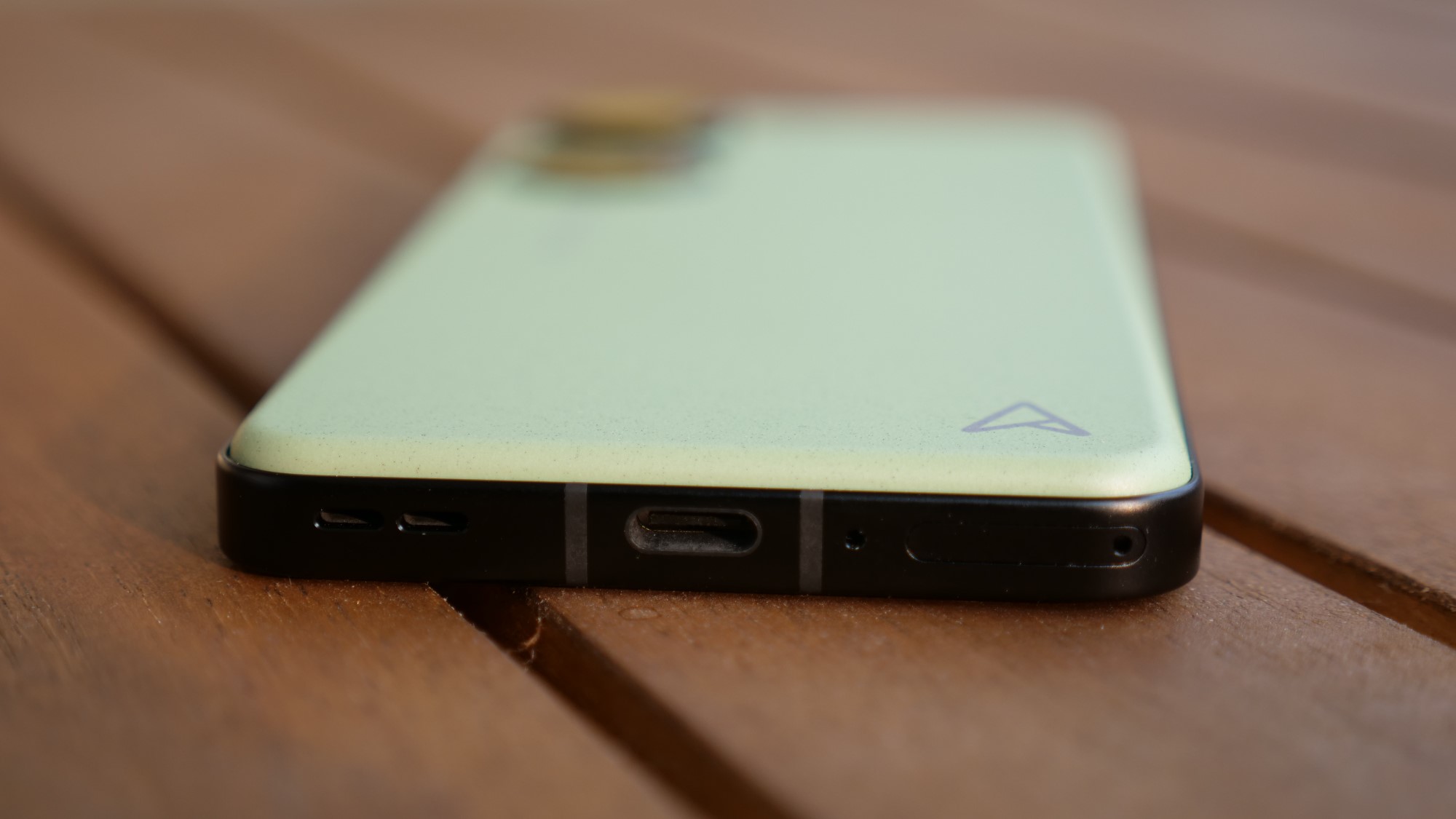
While it is otherwise petite, the Zenfone 10 is slightly thicker than a typical flagship phone in order to accommodate its 4300 mAh battery. I’m glad they did, because after experiencing pretty atrocious battery life with both iPhone minis, I was sure this would be the downfall of the Zenfone 10, but as I’ve already said it is an energy camel that just keeps going.
In our Laptop Mag battery test, the phone continuously surfs the web over a cellular connection with the display set at 150 nits. It lasted for 12 hours and 41 minutes. That is easily enough for a spot on our phones with the best battery life. It also blows past the Pixel 7a (10:05) and managed to threaten the OnePlus 11 (13:10), despite the latter featuring a 700mAh larger battery.
| Battery benchmark | Asus Zenfone 10 | OnePlus 11 | Google Pixel 7a |
|---|---|---|---|
| Battery rundown test (Default) | 12:41 | 13:10 | 10:05 |
| Charge % after 30 minutes of charging | 54% | 99% | 43% |
My typical day with a phone runs from 7:30 a.m. to 10:30 p.m. with a mix of Netflix or YouTube streaming on Wi-Fi for roughly two hours, YouTube Music in the background for a few hours, an hour of a podcast, web browsing, using social media, gaming for about 30 minutes, and capturing photos and videos. I never had to think about the battery life, while I wouldn’t make it through a second day, I wouldn’t worry about my phone still being alive to wake me up with an alarm in the morning if I didn’t plug it in.
The Zenfone 10 supports up to 30W wired fast charging and 15W wireless charging. The wired charge got our Zenfone 10 to 31% in 15 minutes and 54% in 30 minutes. I’d love it to be slightly faster, but with wireless charging support and excellent battery life, it isn’t a real concern.
Asus Zenfone 10 cameras

You can’t miss the dual cameras on the back of the Asus Zenfone 10, they are roughly double the size of the lenses on the back of the iPhone 14 Pro, which are massive in their own right. The primary camera is a wide-angle 50MP with an f/1.9 aperture and 6-axis Hybrid Gimbal Stabilizer 2.0 (more on that later). The ultra-wide is a modest 13MP with an f/2.2 aperture, while the front-facing camera is a 32MP RGBW sensor (more on that later too).
Now I’m going to need to deliver a brief caveat on my photos for the Asus Zenfone 10 as we’ve been in the midst of an air quality problem here that has a haze covering everything, which isn’t exactly conducive to most photos and has restricted my ability to go outside and take photos in general. I’ll update this review with more photos when things clear to give a better idea of what’s possible in “normal” conditions.
With that out of the way, I am happy with the results from the primary camera on the Zenfone 10. It offers realistic but punchy color, and the Asus AI Object Sense will give you an added computational photography boost. Asus also sought to combat the problem of hand-shake on a small phone with its 6-axis Hybrid Gimbal Stabilizer 2.0. That not only allows for smoother video but also enhances handheld low-light photos.
Here’s a sample of shots from the primary camera. I loved the first photo of the purple flowers in our garden, the color is spot on and while it definitely pushed the saturation slightly, it still looks true to life. The second photo shows a mural near my home, unfortunately, the aforementioned haze has things looking a little less colorful than normal, but the capture again is dead on for the scene with sharp detail.

Asus Zenfone 10 - wide-angle

Asus Zenfone 10 - wide-angle

Asus Zenfone 10 - wide-angle

Asus Zenfone 10 - wide-angle

Asus Zenfone 10 - wide-angle
The Zenfone 10 lacks a telephoto lens, but will punch in up to 8x digitally. I appreciate Asus not overreaching there and offering a basically unusable 20x zoom, the results are good all the way up to 8x. I was particularly happy with the 8x zoom version of that same shot of the purple flowers in our garden, the color and natural bokeh look fantastic. Going for a more traditonal telephoto shot on the mural you can see it holds detail well at 8x with the star and lettering all showing clear and sharp lines.

Asus Zenfone 10 digital zoom

Asus Zenfone 10 digital zoom

Asus Zenfone 10 digital zoom

Asus Zenfone 10 digital zoom

Asus Zenfone 10 digital zoom
The ultra-wide is the weak link in the chain for the Zenfone 10 as while the haze isn’t helping anything, the images from it are alternately drained of color or oversaturated. In relatively close-up images in my garden, those purple flowers from earlier lose their pop. Conversely, the reddish-orange of the mural looks almost neon from the ultra-wide.

Asus Zenfone 10 ultra-wide

Asus Zenfone 10 ultra-wide

Asus Zenfone 10 ultra-wide

Asus Zenfone 10 ultra-wide

Asus Zenfone 10 ultra-wide
Flipping around to the front of the phone, the 32MP RGBW sensor is more on par with the primary camera, delivering mostly solid results. The “W” in “RGBW” represents extra white pixels that are meant to give a boost of brightness to the image in dim environments, but I’d note that I think it is universally applied as every selfie I took looked brighter than shots from the primary or ultra-wide in the same settings, but overall I think it works effectively.

Asus Zenfone 10 selfie camera

Asus Zenfone 10 selfie camera
Asus Zenfone 10 software
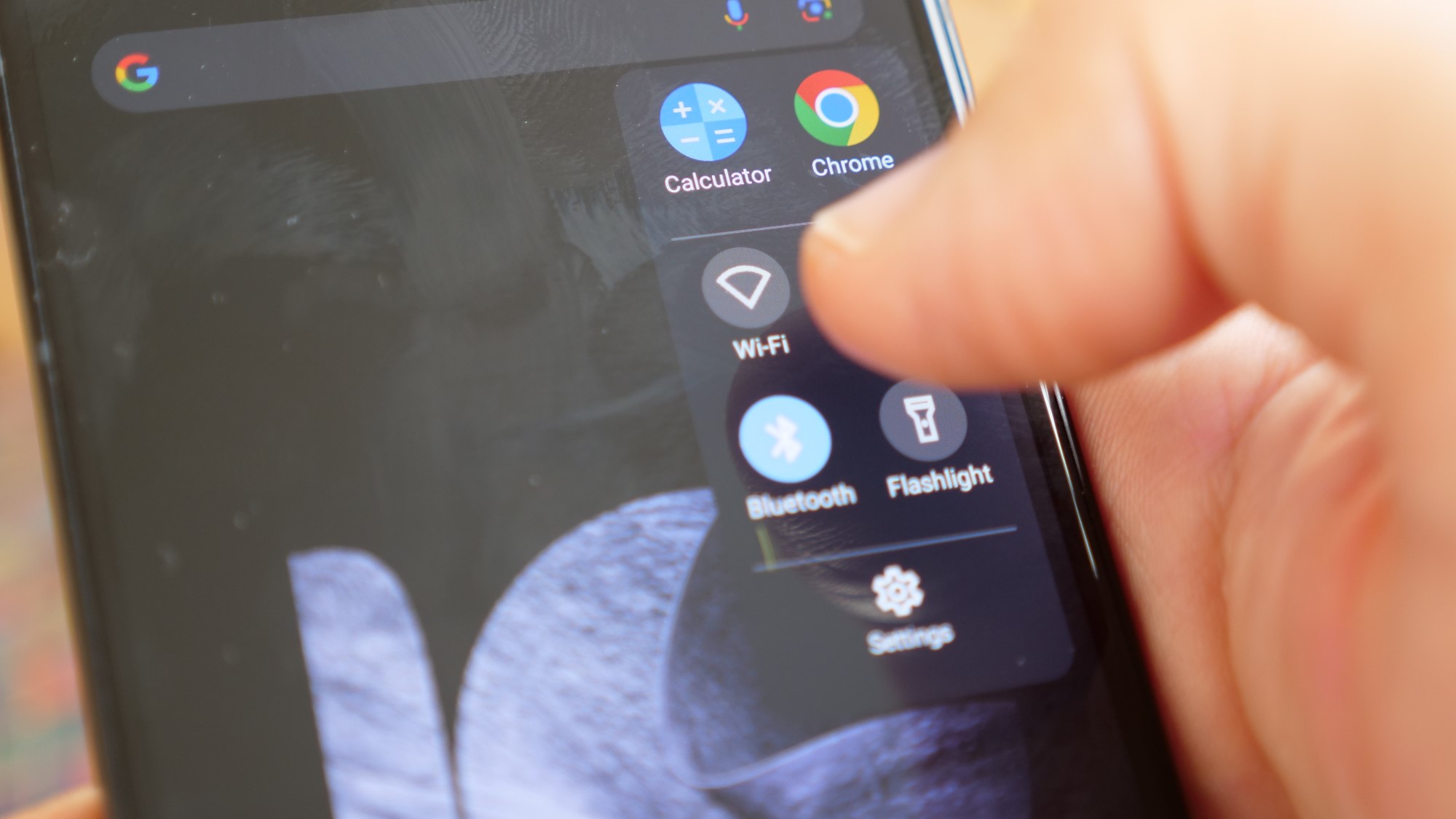
The Asus Zenfone 10 runs Android 13 with a splash of extras from Asus added on. For those that like stock Android, Asus does give you the option at times to choose the stock experience, but it’s worth giving their add-ons a shot as there are some clever and helpful features in there.
One example is the Edge tool, a quick access toolbar that you can slide in from the right side of the display, rather than reaching for the top and bringing up the entire quick settings menu. The smart key on the side of the phone offers a variety of useful extras too. It can be used to fast-forward or rewind any active video on your phone by swiping up or down on it, swipe down on it on other screens to bring your notification shade down without having to reach for it, and if you don’t like those options you can switch to a variety of others.

I mentioned at the outset, software support is one of the areas where Asus comes up shy of Google, Samsung, and OnePlus. It promises two major Android updates and three years of security updates. If Asus would just push it to three major Android updates and four years of security updates I’d have no complaints.
Bottom line
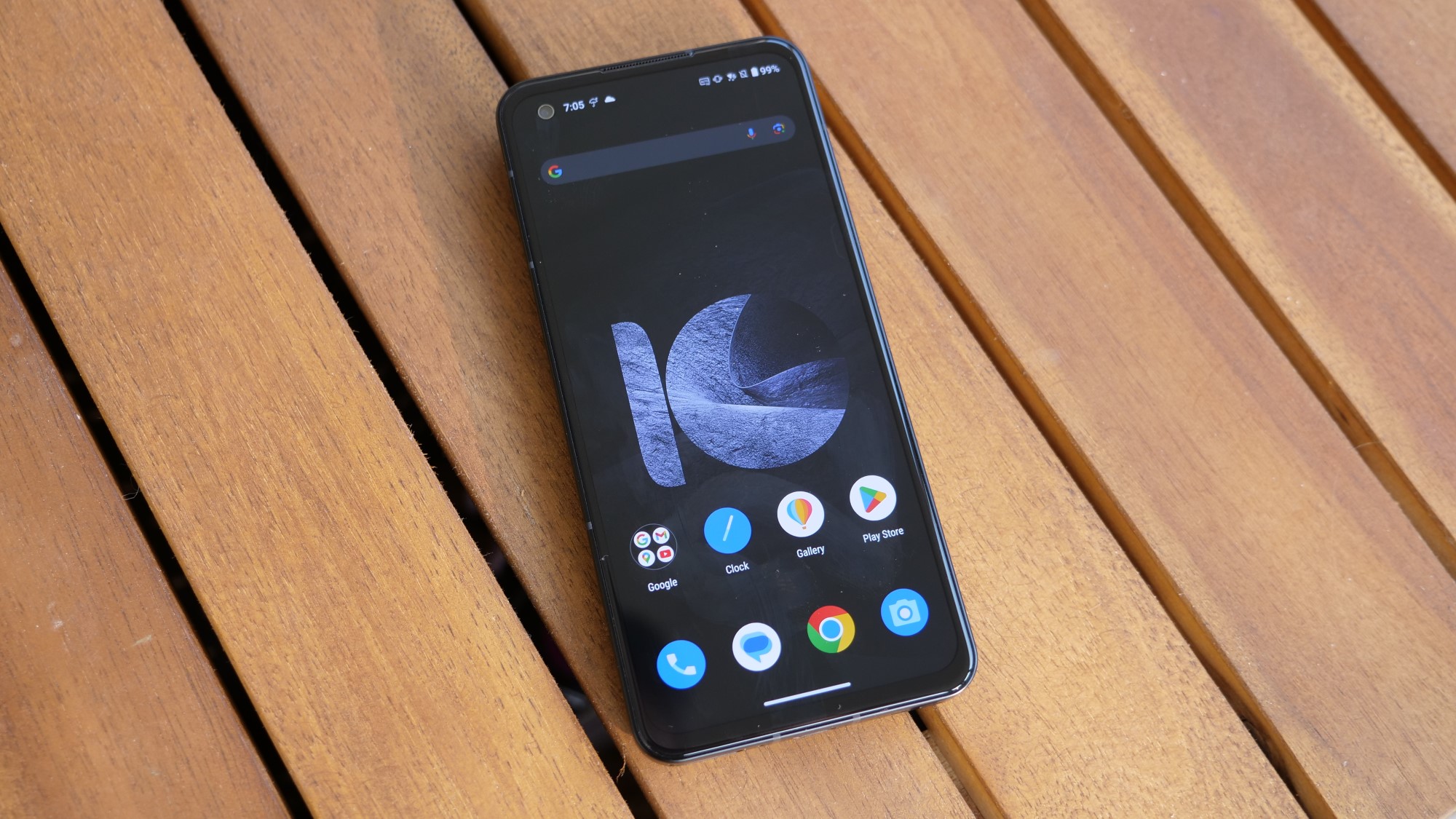
The Asus Zenfone 10 is basically everything the iPhone mini should have been. Pocketable and powerful, while still offering marathon battery life. Not only is the size appealing, but it offers unique and colorful styling that is almost as rare as a small flagship phone in 2023.
While I wish Asus had more thoroughly nailed the entire camera experience, the primary camera and selfie cameras are good enough, that I think most users will be satisfied, despite the disappointing ultra-wide and lack of a telephoto lens.
The only outstanding question on the Asus Zenfone 10 is the cost, but if Asus brings it in at around the same $699 as its predecessor, this is going to be an easy pick for one of the best phones of 2023. If you need a phone right now or don’t want to spend over $500, the Google Pixel 7a is the clear alternative, but if you value performance and battery life over cameras, you’ll want to wait for the Zenfone 10.
Sean Riley has been covering tech professionally for over a decade now. Most of that time was as a freelancer covering varied topics including phones, wearables, tablets, smart home devices, laptops, AR, VR, mobile payments, fintech, and more. Sean is the resident mobile expert at Laptop Mag, specializing in phones and wearables, you'll find plenty of news, reviews, how-to, and opinion pieces on these subjects from him here. But Laptop Mag has also proven a perfect fit for that broad range of interests with reviews and news on the latest laptops, VR games, and computer accessories along with coverage on everything from NFTs to cybersecurity and more.


